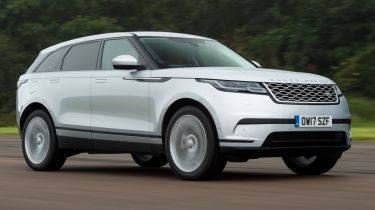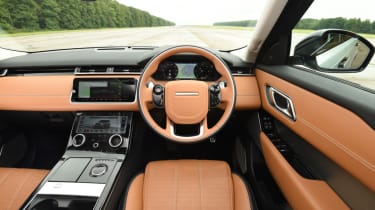Range Rover Velar 2.0 diesel 2017 review
How does the new Range Rover Velar SUV measure up as a four-cylinder diesel?

While the D240 powertrain leaves a little to be desired with an eye-wateringly high list price and a perceived lack of punch, the rest of the Velar package is still deeply impressive. This is one of the most desirable SUVs on sale in Britain today, sitting closer to the larger Range Rover Sport than the ageing Evoque, thanks to its plush interior and space-age styling. HSE spec adds all the bells and whistles, but four-cylinder models miss out on the all-important air-suspension.
The latest addition to Land Rover’s extensive line-up is one of the SUV market’s hottest properties. The Range Rover Velar introduces a fourth car to the firm’s luxury off-roader wing, offering potential customers something a little bit different.
We’ve already driven the 3.0-litre diesel car, and it fared well, however the Porsche Macan still claims top spot in a hotly contested class. Now we’ve got the more modest four-cylinder diesel in the UK to see if a smaller engine makes more sense.
The new-generation 2.0-litre Ingenium unit under the bonnet is available with two power outputs. Basic D180 cars get 178bhp, although the more versatile option is the D240 driven here – boasting 237bhp.
Land Rover has worked its magic on this powertrain in terms of refinement. It’s noticeably hushed, quietly and competently feeding power to the wheels, and only raises its voice with deep lunges on the accelerator pedal. It’s clattery when cold, but it settles down when warm. Claimed economy of 49.7mpg is impressive, too.
Used - available now

2020 Land Rover
Range Rover Velar
110,840 milesAutomaticDiesel3.0L
Cash £18,995
2021 Land Rover
Range Rover Velar
33,376 milesAutomaticDiesel2.0L
Cash £30,500
2023 Land Rover
Range Rover Velar
24,195 milesAutomaticDiesel2.0L
Cash £34,800
2021 Land Rover
Range Rover Velar
36,483 milesAutomaticDiesel2.0L
Cash £30,663The Velar doesn’t seem to make the most of the 237bhp and 500Nm of torque on offer, though, with slack throttle response and real-world performance that leaves the claimed 7.3-second 0-62mph time open to question; the V6 diesel feels far quicker.
There’s also a question mark over the cost, especially when comparing the Velar with more dynamic rivals. The D240 starts at £53,720 in Velar S trim, next to £48,289 for the more powerful, torquier, V6 Porsche Macan S. Elsewhere, the Velar’s engine appears in the Jaguar F-Pace from a far more reasonable £42,115.
Our test Velar had a deeply impressive ride, however, thanks to its optional electronic air-suspension. It soaks up bumps effortlessly while maintaining a firm, reassuring poise through hard cornering. The set-up is standard fit on six-cylinder models, but regardless of our test car’s top-spec HSE status, you’ll have to fork out an extra £1,140 on the 2.0-litre.
The design approach means that in just about any spec the Velar has a well appointed and extremely high-quality cabin – especially thanks to the car’s all-new Duo Touch twin-screen infotainment system. Unsurprisingly, range-topping HSE models add perforated and patterned two-tone leather upholstery, 20-way adjustable seats with heating, cooling and massage functions, as well as a digital instrument panel, plus JLR’s full suite of driver assist tech.
While autonomous emergency braking, lane keep assist, park assist and blind spot assist are all present, the only semi-autonomous feature the Velar has is adaptive cruise control. HSE cars also get 21-inch wheels, a sliding panoramic roof and excellent Matrix LED lights. A 17-speaker Meridian sound system is also included.










